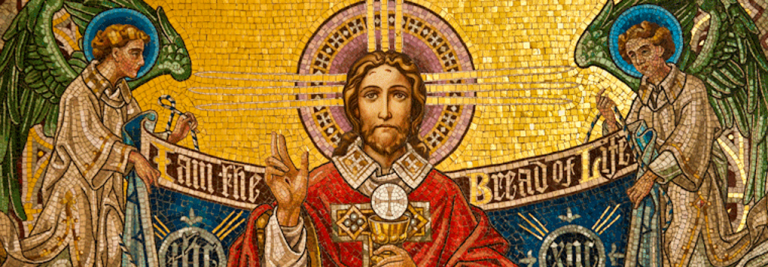The Mystery of the Eucharist
“How can Jesus Christ be truly present in what still appears to be bread and wine? In the liturgical act known as the epiclesis, the bishop or priest, speaking in the person of Jesus Christ, calls upon the Father to send down his Holy Spirit to change the bread and wine into the Body and Blood of Christ, and this change occurs through the institution narrative, by the power of the words of Christ pronounced by the celebrant. The reality that, in the Eucharist, bread and wine become the Body and Blood, Soul and Divinity of Christ without ceasing to appear as bread and wine to our five senses is one of the central mysteries of the Catholic faith. This faith is a doorway through which we, like the saints and mystics before us, may enter into a deeper perception of the mercy and love manifested in and through Christ’s sacramental presence in our midst.” SOURCE: The Mystery of the Eucharist in the Life of the Church, Copyright 2021, © United States Conference of Catholic Bishops, Washington, DC
“He Makes Himself A Gift”
Today, the Solemnity of Corpus Christi, once again, the Lord distributes for us the bread that is his Body; he makes himself a gift. We, too, experience “God’s solidarity” with man, a solidarity that is never depleted, a solidarity that never ceases to amaze us. God makes himself close to us; in the sacrifice of the cross, he humbles himself, entering the darkness of death to give us his life, which overcomes evil, selfishness, and death. Jesus gives himself to us in the Eucharist, shares in our journey; indeed, he makes himself food, the true food which sustains our life also in moments when the road becomes hard going and obstacles slow our steps. And in the Eucharist, the Lord makes us walk on his road, that of service, of sharing, of giving; and if it is shared, that little we have, that little we are, becomes riches, for the power of God—which is the power of love—comes down into our poverty to transform it. So let us ask ourselves, in adoring Christ who is really present in the Eucharist: do I let myself be transformed by him? Do I let the Lord who gives himself to me guide me to going out ever more from my little enclosure, in order to give, to share, to love him and others?” SOURCE: Pope Francis Speaks to Our Hearts: Words of Challenge and Hope. Frederick: The Word Among Us Press, 2013. Print.
The “Rite Way”: How to Receive the Eucharist
It’s important that we as Catholics are together in our understanding of how to receive the Body and Blood of Christ. Communicants are asked to respectfully process to the front of the church with their hands folded in a sign of prayer. Because communicants are receiving Jesus himself, the U.S. bishops have instituted as a norm a slight bow of reverence immediately preceding reception of the Eucharist.
The person distributing Communion will say to each person receiving, “The Body of Christ” or “The Blood of Christ.” Each communicant should clearly respond, “Amen” to affirm and proclaim his or her belief that the consecrated bread and wine are truly the Body and Blood of Christ.
A communicant may receive the Host in the hand or on the tongue. When Communion is received in the hand, the following directions apply. If the person receiving is right-handed, the left hand should rest upon the right. The person distributing will lay the Host in the palm of the left hand. The Host is then taken by the right hand to the mouth by the communicant. If the person receiving is left-handed, this is reversed. Communicants should not reach out with their fingers to take the Host from the person distributing. When a communicant is receiving under the form of wine, communicants are not permitted to dip the Host into the chalice. Upon returning to their seats, communicants should offer a prayer of thanksgiving to God. SOURCE: “Our Sunday Visitor”




